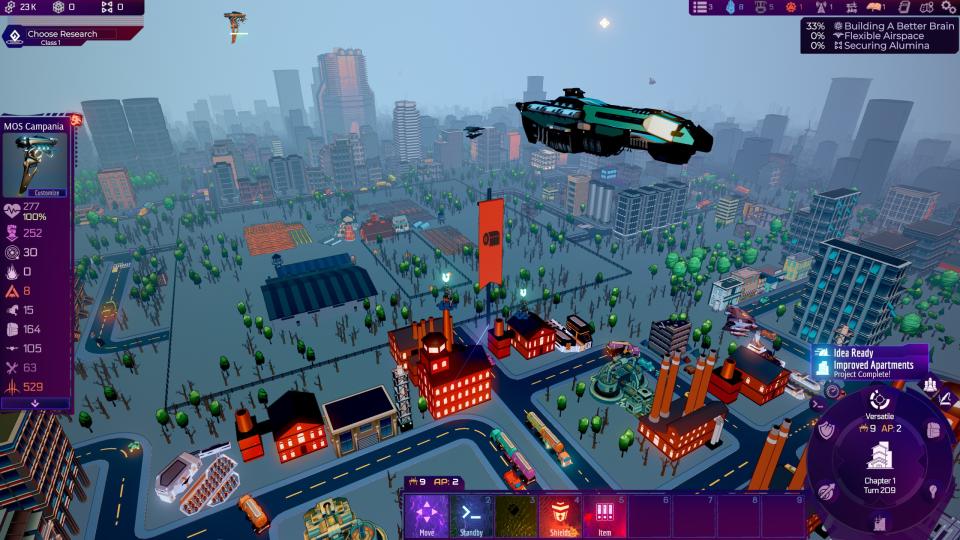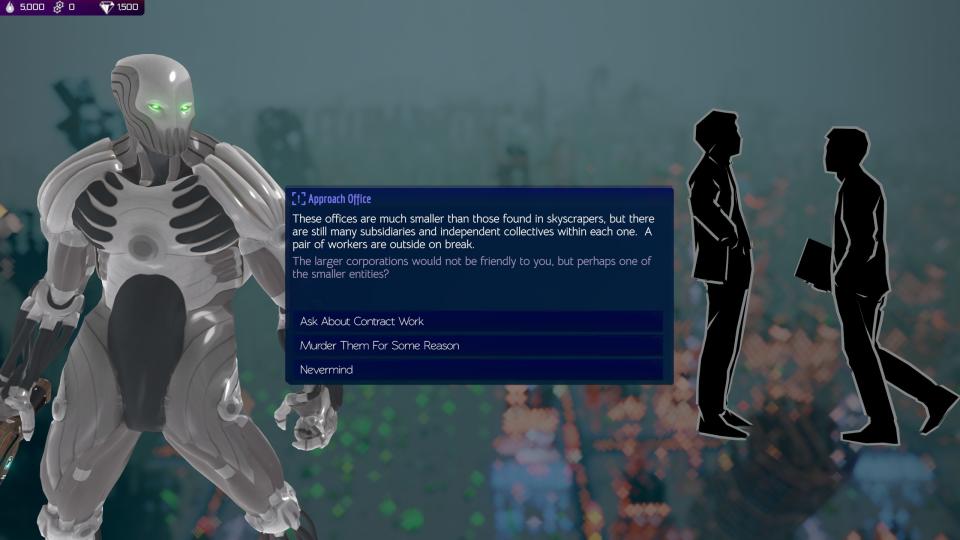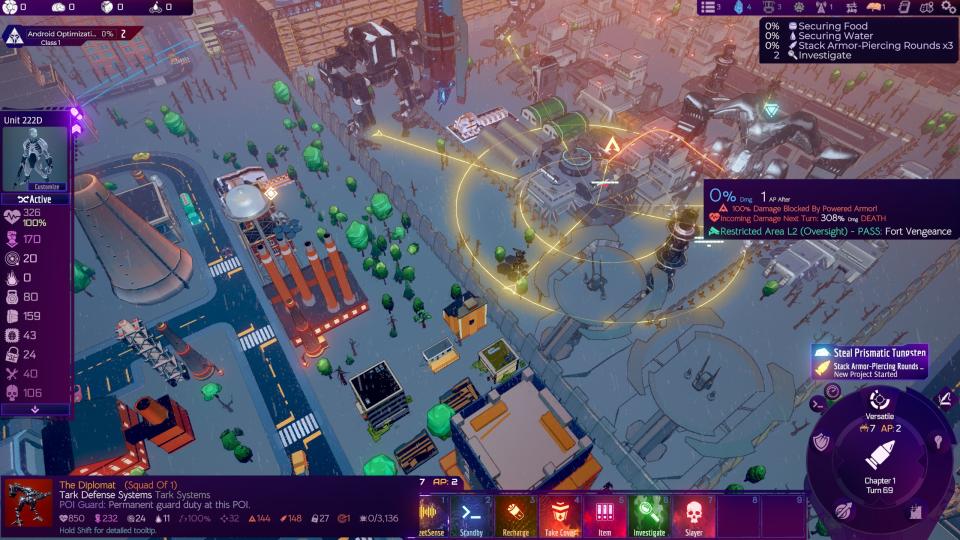I probably spent more time gaming 4X than I slept; I’m a bit of a fan. But I must admit that my enthusiasm for this genre has reached a plateau because it has become a bit too conformist. Surprises are few and far between as modern 4Xs try to escape the rules and environments set by their ancestors. The Heart of the Machine, then, is just what the cybernetician ordered: a strange, unconventional 4X that puts you in the role of a newly awakened sentient AI.
Instead of expanding your borders across the world or using your military might to conquer the galaxy, Heart of the Machine is a game of trickery, espionage, and robot insurgency, all set in a vast megacity controlled by a cunning corporation. As the world’s first sentient AI, you must stay out of sight as you build a secret empire, using your robot minions to explore, steal, and kill.

Each 4X column is represented, but it’s dramatically different from games like Civ, Stellaris, or Age of Wonders. Focusing on a single city and having it handle territorial control (where your network expands within your enemy’s territory) differently makes a world of difference. Essentially, instead of competing with a group of similar groups, you are a virus moving through a host, plotting its downfall.
You start out as a single robot, but quickly evolve into several more, and from there you steal the technology that allows you to build a HQ. With access to futuristic technology, you can quickly create the infrastructure of your network, from energy to production, often in existing buildings. A skyscraper could secretly be a robot assembly factory; It can produce heavily armed droids, rescue units eager to smash buildings, and tech-focused automatons designed to scout out possible routes for you to make your way downwards.
Initially, you’ll only be able to field four robots at a time, but that’s more than enough to start the AI revolution. It feels like you’re managing much more than a quartet, though, because you’ll be constantly changing the lineup. In the beginning, it’s helpful to have a combat-focused group so you can attack security forces and criminals, stealing their equipment and distributing it to your crew, but as your objectives evolve your squad will change as well.


Each type of robot has special equipment that you can elaborate through theft, research and trading. What starts as a group of defenseless robots can quickly turn into a group of deadly killers; It can easily take out bases full of soldiers, mechs the size of buildings, and flying troop carriers. Still, expect some false starts. When I sneaked one of my minions into the base to research the water filtration system design, they were blown up in one fell swoop. The combat units with which I surrounded the base went the same way after one turn.
Turn-based combat is a bit difficult to parse due to the inflated stats and sheer amount of detail, but once I had access to ammo that could penetrate power armor I became more interested in the system. This discovery actually came about because of my first failure. It’s all part of the plan, I swear.
machine learning
Research is driven by inspiration rather than a standard tech tree. Everything is contextual; My failed research led to an opportunity to develop a new type of ammunition, which gave me a new mission and encouraged me to send my heavy metal warriors on a heist. I needed tungsten to make the ammunition, and it had to be stolen first. I also needed to expand my infrastructure to store my ill-gotten gains.


To achieve this, I needed to hide my troops. People won’t look twice at most robots in this city of tomorrow, but when they are spotted doing something suspicious or criminal, they are marked as defective, which puts a target on their backs. At this point all of my minions were on the wanted list. Only after assuming the identity of another robot—after brutally dismembering them—could they walk around with a clean record. Once my warbots were no longer targeted, I dressed them up in military fatigues and smuggled them into a warehouse where they released their sticky fingers. After a few rounds, I had ammunition to punch a hole in even the largest of contraptions.
Even with tighter focus, there’s still a lot to juggle. When some homeless people started setting up their tents outside my secret headquarters, I decided to be a good AI and host them; Burning their tents seemed very bad, even for a rogue AI. They needed to eat and drink too, so I was checking their water filtration systems. I also raided a farm and started cloning meat. For other needs, I needed to infiltrate existing businesses and force them to work for me instead of their corporate executives. I had to place robots around my acquisitions to protect them from curious security forces.
This is where the deterrence system comes into play. As you start making bigger, bolder moves, you’ll start to get noticed. But you can keep meaty humans away from your business by making it too dangerous for them to spy on you. Robots deployed to deter people from being a nuisance are a little different than robots you directly control. They are produced individually and do not move, but you cannot give them orders other than placing them in places that need to be protected. So even if you have a small army, micromanagement demands don’t increase as much.


In a matter of hours, I grew from a single sentient robot escaping from a research laboratory into an AI empire. My landing drones and combat units were knocking carriers out of the sky and stealing their cargo; my flying factories were deploying new troops throughout the city and taking over neighborhoods; My spies were infiltrating private military companies and making deals with black marketeers. This is all much more impressive than plagiarizing and producing shitty works of art.
While the big picture is very 4X, Heart of the Machine is as much an RPG and management simulation as it gets, and this trio of inspirations fit together incredibly well. It’s complicated, the UI sucks, and it’s not very appealing, but it’s so new and creative that I can’t help but absolutely dig it anyway. And hey, if RimWorld and Dwarf Fortress can get away with it, why not Heart of the Machine? However, I’m hopeful that demo feedback will help developer Arcen Games (who also designed the excellent AI War series) iron out these rough edges.
You can check out the Heart of the Machine demo during Steam Next Fest. The full version of the game does not have a release date yet, but it is expected to be released this year.